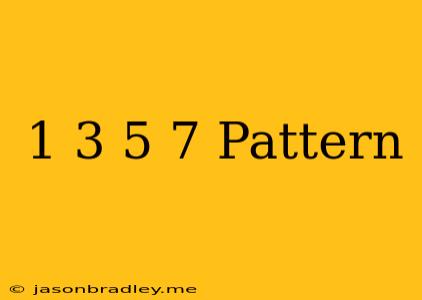The Enchanting 1 3 5 7 Pattern: Exploring the World of Odd Numbers
The sequence 1, 3, 5, 7... might seem simple at first glance. It's just a list of odd numbers, right? But beneath its apparent simplicity lies a captivating world of mathematical patterns, intriguing properties, and unexpected connections to other areas of mathematics and even science.
A Sequence of Odd Numbers
At its core, the 1 3 5 7 pattern is simply the sequence of odd positive integers, meaning whole numbers greater than zero that are not divisible by 2.
Here's how it's constructed:
- Start with 1.
- Add 2 to the previous number to get the next.
This simple rule generates the entire sequence: 1, 3, 5, 7, 9, 11, 13, and so on.
More than Just Odd Numbers
While the 1 3 5 7 pattern is a straightforward representation of odd numbers, it holds deeper mathematical significance. Here are a few fascinating aspects:
-
Sum of Consecutive Odd Numbers: Notice that the sum of the first n odd numbers is always equal to n squared.
For example:
- 1 = 1²
- 1 + 3 = 4 = 2²
- 1 + 3 + 5 = 9 = 3²
- 1 + 3 + 5 + 7 = 16 = 4²
-
Relationship to Squares: The 1 3 5 7 pattern is also intimately linked to the difference between consecutive square numbers. The difference between any two consecutive square numbers is always an odd number.
For example:
- 4² - 3² = 16 - 9 = 7
- 5² - 4² = 25 - 16 = 9
- 6² - 5² = 36 - 25 = 11
-
Applications in Number Theory: The 1 3 5 7 pattern plays a role in number theory, particularly in the study of prime numbers. For instance, every prime number greater than 2 is an odd number, and therefore can be found in the 1 3 5 7 pattern.
Beyond Mathematics
The 1 3 5 7 pattern extends its reach beyond the realm of pure mathematics. It finds surprising applications in:
- Physics: In the study of quantum mechanics, the energy levels of certain systems, such as the hydrogen atom, are quantized and can be represented by the 1 3 5 7 pattern.
- Computer Science: The pattern is used in algorithms and data structures, such as hashing and sorting.
- Music: Some musical scales and chords are based on the intervals represented by the 1 3 5 7 pattern.
Conclusion
The seemingly simple 1 3 5 7 pattern reveals a fascinating world of mathematical relationships, interconnectedness, and unexpected applications. It serves as a reminder that even the most basic patterns can hold profound depths and connect to various fields of study.
